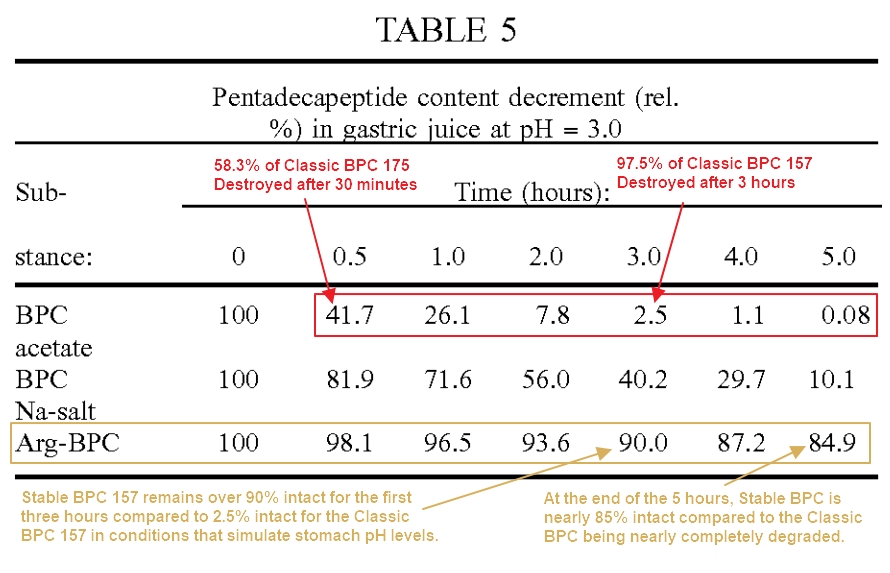How Bpc-157 Works In The Body Extreme bradycardia and asystole appeared as the ultimate outcome, at 20 ± 2 minutes (50 mmHg), 25 ± 5 min and 28 ± 2 min (30 mmHg and 40 mmHg), and 55 ± 8 min (25 mmHg) in control rats under thiopental anesthesia and at 110 ± 25 min in esketamine-anesthetized control rats. Nevertheless, the proof shows that in spite of continuously preserving high intra-abdominal pressure, in all BPC 157-treated rats, heart feature was continually preserved, with fewer ECG disturbances. The sinus rhythm was preserved, with periodic first-degree AV block, however without ST-elevation. This happened together with typical heart tiny discussion, unlike the myocardial congestion and sub-endocardial infarction observed in controls (Number 11). BPC 157 (GEPPPGKPADDAGLV, molecular weight 1,419; Diagen, Slovenia) was prepared as a peptide with 99% high-performance fluid chromatography (HPLC) purity, with 1-des-Gly peptide being the primary pollutant. The dose and application regimens were as defined formerly (Duzel et al., 2017; Amic et al., 2018; Drmic et al., 2018; Vukojevic et al., 2018; Sever et al., 2019; Cesar et al., 2020; Gojkovic et al., 2020; Kolovrat et al., 2020; Vukojevic et al., https://connergjso205.hpage.com/post1.html 2020).
Clearing Up The Bpc 157 Restriction: Healing Potential Vs Fda's Position
Stomach compartment disorder looked like a numerous occlusion disorder that can not be prevented unless treatment was provided. On a regular basis, reciprocal adjustments in the abdominal, thoracic, and brain tooth cavities (Depauw et al., 2019) rapidly looked like components of vascular failing. Consequently, in the rats with intra-abdominal high blood pressure, multiorgan failing (i.e., intestinal, mind, heart, liver, and kidney sores), portal and caval hypertension, aortal hypotension, intracranial (superior sagittal sinus) high blood pressure, and generalized apoplexy showed up. This led to generalized stasis, generalised Virchow triad presentation, and severe ECG disturbances; therapy was able to give appropriate compensation (i.e., activation of collateral pathways to reestablish blood flow), both rapid and sustained, as shown with BPC 157 therapy. As a prime and sensible confirmation, rats with major vessel ligation and occlusion, in either artery and/or capillary, and either peripherally or centrally, showed a similar disorder (Vukojevic et al., 2018; Gojkovic et al., 2020; Kolovrat et al., 2020; Gojkovic et al., 2021a; Knezevic et al., 2021a; Knezevic et al., 2021a; Knezevic et al., 2021b). Therefore, there might be a shared lack of ability to react, resulting in innate vascular failure upon major vessel occlusion (ligation) (Vukojevic et al., 2018; Gojkovic et al., 2020; Kolovrat et al., 2020; Gojkovic et al., 2021a; Knezevic et al., 2021a; Knezevic et al., 2021a; Knezevic et al., 2021b) in addition to upon the induction of high intra-abdominal pressure, with all vessels pressed.Bpc 157 Peptide Bpc 157 Review, Side Effects, Dosage, Cycles, Before And After Results - Outlook India
Bpc 157 Peptide Bpc 157 Review, Side Effects, Dosage, Cycles, Before And After Results.


Posted: Tue, 08 Aug 2023 07:00:00 GMT [source]
The Fda's Placement On Bpc 157
Likewise, starting on day 7, the controls exhibited edema and the loss of nerve cells in the former horn and intermediate noodle, disturbances that were greatly counteracted the in BPC 157-treated rats (Table 2 and Fig. 5). Prior to sacrifice, the pets from the 30-, 90-, 180-, and 360-day postspinal cable injury interval teams were put in a wood box with their tails revealed. Three sets of monopolar needles were stabbed 3 mm deep into the tail 10, 60, and 100 mm caudal to the tail base. Using a TECA 15 electromyography apparatus with a signal filter in between 50 Hz and 5 kHz, volunteer muscular tissue task was tape-recorded from the most back pair of electrodes, and the ordinary motor unit possible (MUP) was videotaped. After that, the compound motor action possibility (CMAP) was recorded from the very same check here set of electrodes after stimulating the initial and 2nd electrodes (a repetition of 1 Hz and a stimulation duration of 0.05 ms).High Blood Pressure Disruptions
The reliable dose of BPC157 for the therapy of numerous injuries in mice, rats, and rabbits ranges from 6 to 50 μg/ kg (Huang et al., 2015; Mota et al., 2018; Sikiric et al., 2018). Our suggested clinical dosage of BPC157 was 200 µg/ person/day, and its equivalent dose in rats was 20 μg/ kg (transformed based upon body surface area). For that reason, we carried out pharmacokinetic research studies of BPC157 in rats adhering to a single intravenous (IV) management of 20 μg/ kg, solitary intramuscular (IM) administration of dosages 20, 100, or 500 μg/ kg, and duplicated IM administrations of 100 μg/ kg of BPC157 for seven successive days.- BPC 157, in any way examined periods, given in your area or intraperitoneally, accelerated post-injury muscle healing and also aided to restore the full feature.The abdominal wall surface conformity threshold was crossed mechanically, without additional stretch of the abdominal area; this raised intra-abdominal pressure, pressed vessels and body organs, and rose the diaphragm as an established clear-cut outcome (Depauw et al., 2019).Interestingly, the advancement of spasticity began earlier in the rats that undertook spinal cord injury and had been treated with BPC 157 than in the equivalent controls.There is no way to understand if the substance BPC-157 is risk-free or beneficial in therapies due to the fact that it has not been checked out thoroughly in humans.
Does BPC 157 rise muscle mass development?
Much more blood vessels indicate boosted blood circulation, nutrient supply, and removal of waste items from muscular tissue cells, every one of which are advantageous for muscle building. That claimed, it''s important to keep in mind that while BPC 157 does promote muscle mass growth, its primary duty is in healing and decreasing swelling.